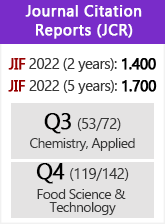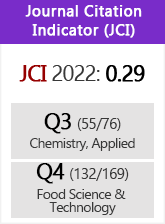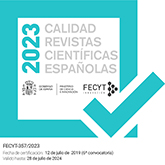Optimization of low thermal treatments to increase hydrophilic phenols in the Alperujo liquid fraction
DOI:
https://doi.org/10.3989/gya.0227221Keywords:
Alperujo, Hydroxytyrosol, Olive mill by products, Phenolic compounds, Thermal treatments, TPOMWAbstract
Hydrophilic phenols are the main bioactive compounds in alperujo. Among them, 3,4-Dihydroxyphenylglycol (DHPG), Hydroxytyrosol (HT) and Tyrosol (Ty), are the most relevant and deeply studied. These compounds exhibit high antioxidant capacity and a wide range of health benefits as well as technologically promising properties. Given that, their recovery represents an attractive opportunity to valorize this by-product. In this work low thermal treatments were applied to alperujo in order to obtain phenol-enriched liquid fractions. Optimization assays combining different levels of temperature (30 to 90 ºC), time (60 to 180 min) and water content (70 to 90%), followed by response surface methodologies were performed. The results indicated that by applying optimal conditions, is possible to obtain theoretical yields of Total phenols, DHPG, HT and Ty of 2.4, 957.8, 3.4 and 6.4 times greater, respectively, than raw dry alperujo. Interestingly, all the evaluated conditions can be reproduced with low investment in a standard olive oil industry.
Downloads
References
Alburquerque JA, Gonzálvez J, García D, Cegarra J. 2004. Agrochemical characterisation of "alperujo", a solid by-product of the two-phase centrifugation method for olive oil extraction. Bioresour. Technol. 91 (2), 195-200. https://doi.org/10.1016/S0960-8524(03)00177-9 PMid:14592750
Balzan S, Cardazzo B, Novelli E, Carraro L, Fontana F, Currò S, Laghetto M, Trocino A, Xiccato G, Taticchi A, Fasolato L. 2021. Employment of phenolic compounds from olive vegetation water in broiler chickens: Effects on gut microbiota and on the shelf life of breast fillets. Molecules 26 (14). https://doi.org/10.3390/molecules26144307 PMid:34299582 PMCid:PMC8306377
Bartella L, Mazzotti F, Talarico IR, Santoro I, Di Donna L. 2021. Hydroxytyrosol fortified foods obtained by supercritical fluid extraction of olive oil. Antioxidants 10 (10). https://doi.org/10.3390/antiox10101619 PMid:34679754 PMCid:PMC8533198
Bermúdez-Oria A, Rodríguez-Gutiérrez G, Rubio-Senent F, Fernández-Prior Á, Fernández-Bolaños J. 2019. Effect of edible pectin-fish gelatin films containing the olive antioxidants hydroxytyrosol and 3,4-dihydroxyphenylglycol on beef meat during refrigerated storage. Meat Sci. 148. https://doi.org/10.1016/j.meatsci.2018.07.003 PMid:30025964
Box G, Behnken D. 1960. Some new three level designs for the study of quantitative variables. Technometrics 2 (4), 455-475. https://doi.org/10.1080/00401706.1960.10489912
Fernández-Prior Á, Bermúdez-Oria A, Millán-Linares MDC, Fernández-Bolaños J, Espejo-Calvo JA, Rodríguez-Gutiérrez G. 2021. Anti-inflammatory and antioxidant activity of hydroxytyrosol and 3,4-dihydroxyphenyglycol purified from table olive effluents. Foods 10 (2). https://doi.org/10.3390/foods10020227 PMid:33499393 PMCid:PMC7912675
Fernández-Prior MÁ, Fatuarte JCP, Bermúdez-Oria A, Viera-Alcaide I, Fernández-Bolaños J, Rodríguez-Gutiérrez G. 2020. New Liquid Source of Antioxidant Phenolic Compounds in the Olive Oil Industry: Alperujo Water. Foods 9 (7). https://doi.org/10.3390/foods9070962 PMid:32708247 PMCid:PMC7404455
Fernández-Prior MÁ, Charfi A, Bermúdez-Oria A, Rodríguez-Juan E, Fernández-Bolaños J, Rodríguez-Gutiérrez G. 2020. Deep eutectic solvents improve the biorefinery of alperujo by extraction of bioactive molecules in combination with industrial thermal treatments. Food Bioprod. Proc. 121, 131-142. https://doi.org/10.1016/j.fbp.2020.02.001
Gil KA, Tuberoso CIG. 2021. Crucial challenges in the development of green extraction technologies to obtain antioxidant bioactive compounds from agro-industrial by-products. Chem. Biochem. Eng. Q. 35 (2), 105-138. https://doi.org/10.15255/CABEQ.2021.1923
Gómez del Campo M, Morales-Sillero A, Vita Serman FV, Rousseaux MC, Searles PS. 2010. El olivar en los valles áridos del Noroeste de Argentina (provincias de Catamarca, La Rioja y San Juan). Olivae 114, 23-45.
Lama-Muñoz A, Gómez-Carretero A, Rubio-Senent F, Bermúdez-Oria A, Maya I, Fernández-Bolaños JG, Vioque B, Fernández-Bolaños J. 2021. Inhibitory effect of olive phenolic compounds isolated from olive oil by-product on melanosis of shrimps. Antioxidants 10 (5), 1-13. https://doi.org/10.3390/antiox10050728 PMid:34063093 PMCid:PMC8147989
Lama-Muñoz A, Rodríguez-Gutiérrez G, Rubio-Senent F, Gómez-Carretero A, Fernández-Bolaños J. 2011. New hydrothermal treatment of alperujo enhances the content of bioactive minor components in crude pomace olive oil. J. Agric. Food Chem. 59 (4), 1115-1123. https://doi.org/10.1021/jf103555h PMid:21265536
Lama-Muñoz A, Rubio-Senent F, Bermúdez-Oria A, Fernández-Bolaños J, Fernández-Prior A, Rodríguez-Gutiérrez, G. 2019. The use of industrial thermal techniques to improve the bioactive compounds extraction and the olive oil solid waste utilization. Innov. Food Sci. Emerg. Technol. 55, 11-17. https://doi.org/10.1016/j.ifset.2019.05.009
Martinez LE, Rizzo PF, Bres PA, Riera NI, Beily ME, Young B. 2021. Compendio de métodos analíticos para la caracterización de residuos, compost y efluentes de origen agropecuario y agroindustrial. Ediciones INTA, Argentina. http://hdl.handle.net/20.500.12123/10587
Monasterio RP, Olmo-García L, Bajoub A, Fernández-Gutiérrez A, Carrasco-Pancorbo A. 2017. Phenolic Compounds Profiling of Virgin Olive Oils from Different Varieties Cultivated in Mendoza, Argentina, by Using Liquid Chromatography-Mass Spectrometry. J. Agric. Food Chem. 65 (37), 8184-8195. https://doi.org/10.1021/acs.jafc.7b02664 PMid:28806514
Monetta P, Bueno L, Cornejo V, González-Aubone F, Babelis, G. 2012. Short-term dynamics of soil chemical parameters after application of alperujo in high-density drip-irrigated olive groves in Argentina. Int. J. Environ. Stud. 69 (4), 578-588. https://doi.org/10.1080/00207233.2012.693290
Monetta P, Renzi L, Suarez E, Cornejo V, Oviedo, A. 2019. Mapa de residuos sólidos y semisólidos de la industria aceitera olivícola de la provincia San Juan (campaña 2016). II Simp. Resid. Agrop. Agroind. NOA Cuyo. 2019, 155-157. Ediciones INTA. https://inta.gob.ar/sites/default/files/inta-libro_de_trabajos_del_ii_sraya_noa_y_cuyo_-san_juan_2018.pdf
Montgomery DC, Wiley JS. Design and analysis of experiments. 1984. Exp. Therm. Fluid Sci. 1 (1), 105.
Morillo JA, Antizar-Ladislao B, Monteoliva-Sánchez M, Ramos-Cormenzana A, Russell NJ. 2009. Bioremediation and biovalorisation of olive-mill wastes. Appl. Microbiol. Biotechnol. 82 (1), 25-39. https://doi.org/10.1007/s00253-008-1801-y PMid:19082586
Munekata PES., Nieto G, Pateiro M, Lorenzo JM. 2020. Phenolic compounds obtained from olea europaea by products and their use to improve the quality and shelf life of meat and meat products, a review. Antioxidants 9 (11), 1-24. https://doi.org/10.3390/antiox9111061 PMid:33138148 PMCid:PMC7692586
Navarro AE, Cegarra J, Roig A, Garcia D. 1993. Relationships between organic matter and carbon contents of organic wastes. Biores. Tech. 44 (3), 203-207. https://doi.org/10.1016/0960-8524(93)90153-3
Niknam SM, Kashaninejad M, Escudero I, Sanz MT, Beltrán S, Benito, JM. 2021. Valorization of olive mill solid residue through ultrasound-assisted extraction and phenolics recovery by adsorption process. J. Clean. Prod. 316. https://doi.org/10.1016/j.jclepro.2021.128340
Obied HK, Bedgood D, Mailer R, Prenzler PD, Robards K. 2008. Impact of cultivar, harvesting time, and seasonal variation on the content of biophenols in olive mill waste. J. Agric. Food Chem. 56 (19). https://doi.org/10.1021/jf801802k PMid:18781756
Owen RW, Haubner R, Mier W, Giacosa A, Hull WE, Spiegelhalder B, Bartsch, H. 2003. Isolation, structure elucidation and antioxidant potential of the major phenolic and flavonoid compounds in brined olive drupes. Food Chem. Toxicol. 41 (5). https://doi.org/10.1016/S0278-6915(03)00011-5 PMid:12659724
Rodríguez G, Rodríguez R, Jiménez A, Guillén R, Fernández-Bolaños J. 2007. Effect of steam treatment of alperujo on the composition, enzymatic saccharification, and in vitro digestibility of alperujo. J. Agric. Food Chem. 55 (1), 136-142. https://doi.org/10.1021/jf0616513 PMid:17199324
Roig A, Cayuela ML, Sánchez-Monedero MA. 2006. An overview on olive mill wastes and their valorisation methods. Waste Manag. 26 (9), 960-969. https://doi.org/10.1016/j.wasman.2005.07.024 PMid:16246541
Rubio-Senent F, Fernández-Bolaños J, García-Borrego A, Lama-Muñoz A, Rodríguez-Gutiérrez G. 2017. Influence of pH on the antioxidant phenols solubilised from hydrothermally treated olive oil by-product (alperujo). Food Chem. 219, 339-345. https://doi.org/10.1016/j.foodchem.2016.09.141 PMid:27765236
Rubio-Senent F, Rodríguez-Gutiérrez G, Lama-Muñoz A, Fernández-Bolaños J. 2013. Phenolic extract obtained from steam-treated olive oil waste: Characterization and antioxidant activity. LWT - Food Sci. Technol. 54 (1), 114-124. https://doi.org/10.1016/j.lwt.2013.04.011
Servili M, Esposto S, Fabiani R, Urbani S, Taticchi A, Mariucci F, Selvaggini R, Montedoro G. F. 2009. Phenolic compounds in olive oil: Antioxidant, health and organoleptic activities according to their chemical structure. Inflammopharmacology 17, (2) 76-84. https://doi.org/10.1007/s10787-008-8014-y PMid:19234678
Singleton VL, Rossi JA. 1965. Colorimetry of total phenolics with phosphomolybdic-phosphotungstic acid reagents. Am. J. Enol. Vitic. 16, (3) 144-158.
Published
How to Cite
Issue
Section
License
Copyright (c) 2023 Consejo Superior de Investigaciones Científicas (CSIC)

This work is licensed under a Creative Commons Attribution 4.0 International License.
© CSIC. Manuscripts published in both the printed and online versions of this Journal are the property of Consejo Superior de Investigaciones Científicas, and quoting this source is a requirement for any partial or full reproduction.All contents of this electronic edition, except where otherwise noted, are distributed under a “Creative Commons Attribution 4.0 International” (CC BY 4.0) License. You may read here the basic information and the legal text of the license. The indication of the CC BY 4.0 License must be expressly stated in this way when necessary.
Self-archiving in repositories, personal webpages or similar, of any version other than the published by the Editor, is not allowed.
Funding data
Instituto Nacional de Tecnología Agropecuaria
Grant numbers PE I 150;PD I 518
Consejo Superior de Investigaciones Científicas
Grant numbers EMHE MHE-200059
















